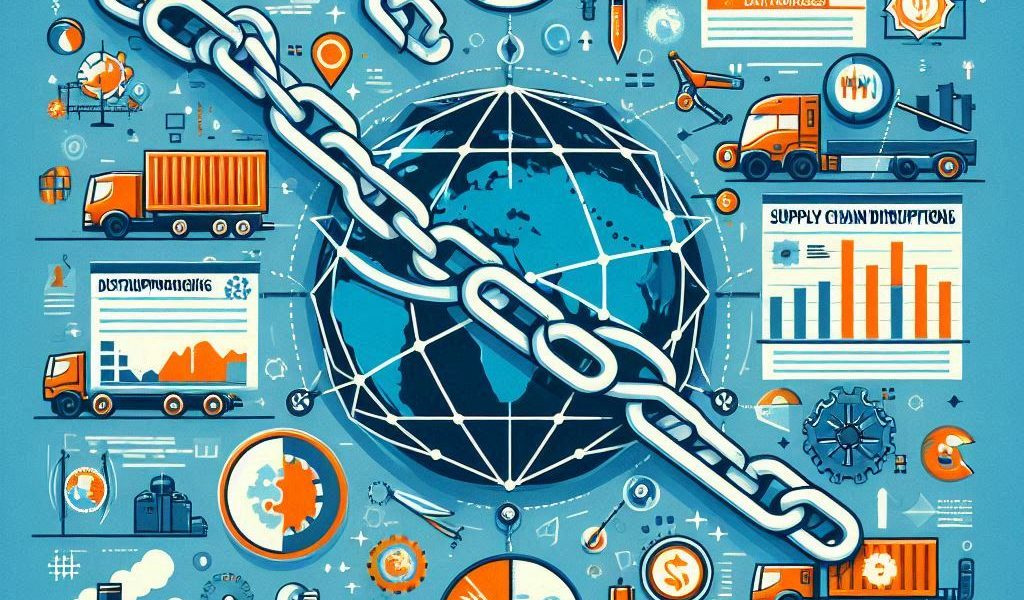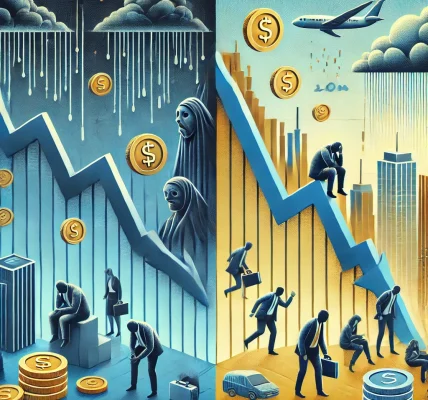Supply chain disruptions have become one of the most pressing issues for global economies in recent years. Whether due to the COVID-19 pandemic, geopolitical tensions, or natural disasters, disruptions in the flow of goods and services can have far-reaching consequences. These disruptions can lead to shortages, price hikes, delays in production, and shifts in consumer behavior. For investors, understanding how supply chain disruptions impact different industries and economies is essential for making informed investment decisions.
In this blog, we will explore how supply chain disruptions are reshaping the global economy, the key drivers behind these disruptions, and what businesses and investors can do to mitigate the risks involved.
What is a Supply Chain Disruption?
A supply chain disruption occurs when there is an interruption in the normal flow of goods and services from suppliers to consumers. These disruptions can happen at any point in the supply chain, from raw materials to manufacturing to transportation and delivery. When any part of the supply chain is affected, it can result in delays, increased costs, and shortages of products, which in turn can disrupt the broader economy.
1. Key Causes of Supply Chain Disruptions
Global Pandemics (e.g., COVID-19)
The COVID-19 pandemic was one of the most significant events to disrupt global supply chains in modern history. Factory closures, transportation restrictions, and workforce shortages resulted in widespread disruptions across multiple industries. The pandemic highlighted vulnerabilities in the global supply chain and exposed the risks of relying on a just-in-time inventory system, where goods are delivered only when needed.
- Factory Shutdowns: Manufacturing plants across the globe were forced to shut down or operate at limited capacity, leading to delays in production.
- Transportation Bottlenecks: With restrictions on international travel and limited shipping options, the movement of goods across borders was severely impacted. Ports became congested, and shipping times were delayed.
- Labor Shortages: Worker absenteeism due to illness, quarantine measures, and social distancing protocols led to staffing shortages in essential industries, affecting production lines and logistics.
The pandemic also exposed the fragility of global supply chains, especially in industries that depend on a few key suppliers or regions for their raw materials and goods.
Geopolitical Tensions and Trade Wars
Geopolitical events, such as trade wars, tariffs, and international conflicts, have a significant impact on global supply chains. For instance, the ongoing trade war between the U.S. and China has caused disruptions in the flow of goods between the two countries, impacting industries like electronics, automotive, and agriculture.
- Tariffs and Trade Barriers: Increased tariffs and restrictions on imports and exports can raise costs and slow down the movement of goods across borders.
- Sanctions: Economic sanctions on countries like Russia, Iran, and North Korea can disrupt the supply of critical goods such as oil, gas, and raw materials.
- Global Logistics: Political instability in key global trading hubs, such as the Middle East or Southeast Asia, can cause bottlenecks and delays in international shipping.
Geopolitical risks are particularly relevant for businesses with global supply chains or those relying on foreign suppliers. For investors, these risks must be carefully considered when assessing the stability of certain sectors and the long-term prospects of multinational companies.
Natural Disasters and Climate Change
Natural disasters, including hurricanes, earthquakes, and floods, can severely disrupt supply chains. These events can damage critical infrastructure such as ports, roads, and factories, leading to delays in production and transportation. Climate change is also expected to increase the frequency and severity of extreme weather events, exacerbating supply chain risks.
- Infrastructure Damage: Disasters can destroy factories, warehouses, and transportation networks, making it difficult to move goods efficiently.
- Agricultural Disruptions: Natural disasters can destroy crops, leading to shortages of food and raw materials for manufacturing.
- Supply Shortages: Disruptions in one region can lead to global shortages of goods, especially in industries reliant on specific raw materials or components from a particular area.
As climate change accelerates, the potential for more frequent and intense natural disasters increases, which can further strain supply chains and the global economy.
2. Impacts of Supply Chain Disruptions on the Global Economy
Increased Costs and Inflation
When supply chains are disrupted, the cost of goods and services rises. This is due to higher production costs, transportation delays, and shortages of materials. As a result, businesses often pass these increased costs onto consumers in the form of higher prices, leading to inflation. For instance, supply chain disruptions during the pandemic contributed to rising prices in sectors such as electronics, automobiles, and food.
- Rising Prices: Shortages in key goods lead to price hikes, especially for products that are essential or in high demand.
- Inflationary Pressures: Widespread disruptions can create inflationary pressures across various sectors of the economy, affecting consumer purchasing power.
Inflation resulting from supply chain disruptions can also lead to tighter monetary policies, such as higher interest rates, which in turn affect investment strategies and economic growth.
Slow Economic Recovery
Supply chain disruptions can impede the pace of economic recovery following a crisis, as they delay production, reduce consumer spending, and lead to job losses. The longer it takes for supply chains to recover, the longer it will take for economies to bounce back. For businesses, this means slower growth, while investors may see delayed returns on investments.
- Production Delays: Slower production timelines affect industries such as manufacturing, automotive, and consumer goods.
- Job Losses: Industries impacted by supply chain issues may have to lay off workers, leading to higher unemployment rates and reduced consumer confidence.
- Investment Risk: As companies struggle to meet demand, stock prices may stagnate, and investment portfolios could experience volatility.
Impact on Global Trade
Supply chain disruptions directly affect global trade by increasing transportation times, reducing the flow of goods, and raising costs. This leads to a decrease in trade volumes, which negatively impacts countries and industries dependent on exports.
- Global Trade Slowdown: When supply chains are broken, international trade volumes drop, and countries may turn inward, adopting protectionist policies.
- Regional Economic Declines: Countries that rely heavily on exports may experience significant slowdowns in economic growth, affecting their GDP and overall economic stability.
3. How Businesses and Investors Can Mitigate Risks
Diversification of Supply Chains
One of the most effective ways to mitigate the risks of supply chain disruptions is diversification. Companies that rely on a single source for critical components or raw materials are more vulnerable to disruptions. By diversifying suppliers and manufacturing locations, businesses can reduce the impact of localized disruptions.
- Multiple Suppliers: Businesses can establish relationships with multiple suppliers to reduce the risk of a single point of failure.
- Local Sourcing: Moving some manufacturing or sourcing closer to home can reduce reliance on global supply chains and improve resilience.
Investing in Technology and Automation
Businesses can invest in technologies that improve supply chain management, such as artificial intelligence, blockchain, and automation. These technologies can help businesses predict and respond to disruptions more effectively, improve inventory management, and streamline logistics.
- AI and Predictive Analytics: Artificial intelligence can help businesses predict potential disruptions and optimize supply chain operations.
- Blockchain: Blockchain technology can improve transparency and traceability within supply chains, making it easier to identify issues and take corrective action.
- Automation: Automated processes in warehousing, manufacturing, and transportation can reduce reliance on human labor and improve efficiency.
Investing in Resilient Industries
For investors, identifying industries that are more resilient to supply chain disruptions is key. Sectors like technology, healthcare, and renewable energy tend to have more robust supply chains due to their reliance on innovation and local sourcing.
- Technology: Tech companies with in-house production and diversified supply chains are likely to weather disruptions better.
- Healthcare: With an increasing focus on healthcare infrastructure, businesses in pharmaceuticals, medical devices, and biotechnology may offer long-term growth potential.
- Renewable Energy: As the world transitions to renewable energy, companies involved in solar, wind, and electric vehicle manufacturing are expected to experience significant growth, even in the face of supply chain challenges.
4. Conclusion: Navigating Supply Chain Disruptions in the Global Economy
Supply chain disruptions are an ongoing challenge for businesses, governments, and investors. By understanding the key drivers behind these disruptions and their impact on global economies, businesses can take steps to mitigate risks and adapt to changing conditions. For investors, staying informed about supply chain trends and identifying resilient industries is essential for navigating an increasingly complex economic landscape.




